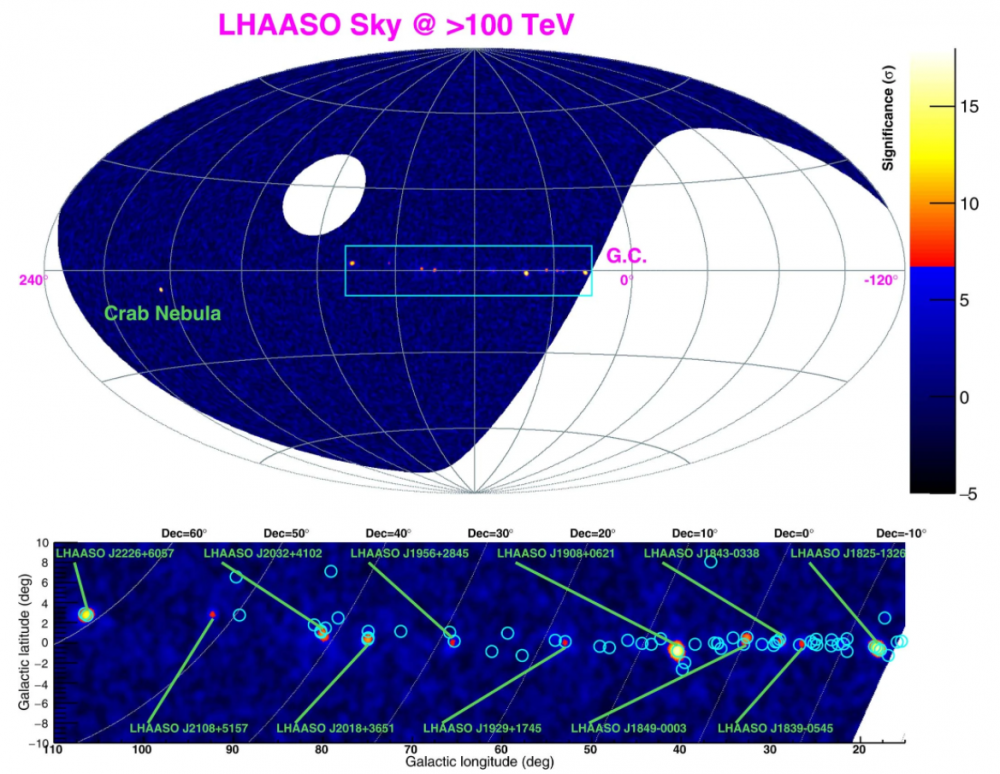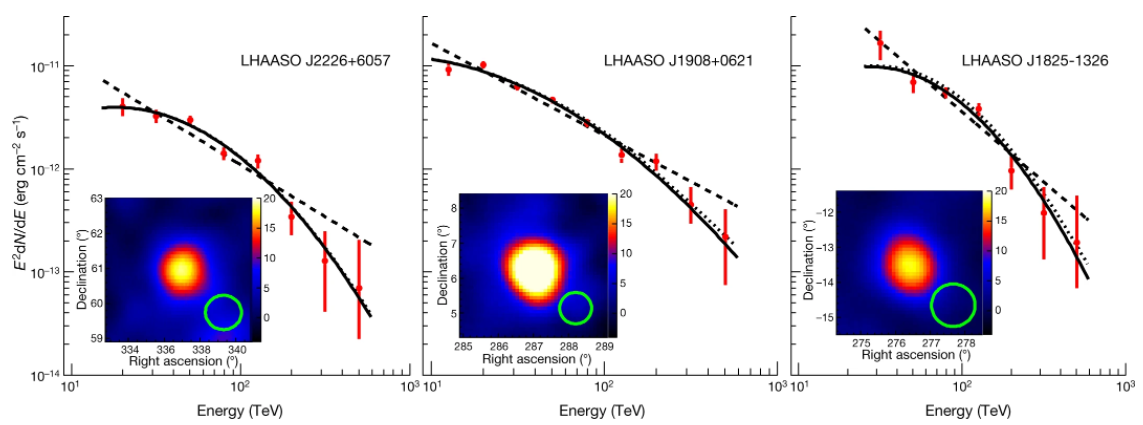Scientists working at the Chinese LHAASO observatory have recorded 530 photons with energies between 0.1 and 1.4 petaelectronvolts from 12 sources within the Milky Way. One of them turned out to be the Crab Nebula but the exact location and nature of the other 11 sources could not be determined. Such observations confirm the existence of galactic pevatrons.
These are cosmic accelerators in our galaxy, which accelerate particles to energies of the order of petaelectronvolts. Their study will make it possible to understand what such objects are and what physical processes lie at their basis.
Cosmic rays and PeVatrons: Scientific Background
Physicists have known for more than a hundred years about the existence of cosmic rays – high-energy particles, the sources of which are extraterrestrial objects.
The energy of such particles reaches enormous values (up to 10 21 electron volts – a hundred million times more than the energy of particles in the Large Hadron Collider), but scientists still cannot say with certainty which space objects can lead to such acceleration.
Candidates for such accelerators are regions of star birth, pulsars, supernova remnants, and massive black holes, but so far it has not been possible to unambiguously connect specific cosmic objects and ultrahigh-energy cosmic rays.
Cosmic rays with energies of the order of petaelectronvolts are of particular interest: at this point of the energy spectrum of cosmic rays, there is a so-called “knee” – a break in the curve of this spectrum. Scientists associate such a break with the different nature of cosmic rays with lower and higher energy values.
Particles with energies of the order of a petaelectronvolt arrive on Earth from space accelerators within the Milky Way. It is precisely the hypothetical sources of such particles that are called pevatrons. Cosmic rays with much higher energies, in turn, can reach us and from other galaxies, which is why their flux falls.
Nevertheless, it was not possible to detect pevatrons within our Galaxy until recently. The galactic center was called the source of cosmic protons with energies up to 0.04 petaelectronvolts. in particular, the supermassive black hole at the center of the Milky Way.
But the determination of the sources of charged particles is complicated by the fact that the latter, in the course of their motion, manage to deviate from the initial trajectory due to strong magnetic fields in outer space and around their sources.
In this case, physicists are helped by high-energy photons, which should be produced in the interaction of accelerated protons and other charged particles with the space environment.
Such gamma quanta, unlike charged particles, are not deflected by a magnetic field, which means that the position of their source can be determined by their direction of motion.
Physicists have already recorded such gamma radiation with energies slightly above 0.1 peta-electron-volt, but the study of pevatrons requires stable registration of photons with significantly higher energies.
10 Things you should know about the newly-discovered PeVatrons
1. Chief scientist Zhen Cao, together with colleagues, presented the results of measurements at the LHAASO observatory: scientists managed to register 530 photons with energies from 0.1 to 1.4 petaelectronvolts from 12 sources within the Milky Way.
2. The statistical accuracy of the fact that each of the 12 detected objects is a source of gamma quanta with an energy of more than 0.1 peta-electron-volt turned out to be more than 7σ.
3. The maximum energy of gamma quanta of 1.42 ± 0.13 petaelectrovolts was recorded for only one of the sources; for the rest of the objects, this value ranges between 0.2 and 0.9 petaelectronvolts.

4. One of the sources turned out to be the Crab Nebula – the remnant of a supernova explosion a thousand years ago. For the LHAASO observatory, this nebula is visible as a point in the starry sky that does not overlap with similar objects in space. Thanks to this, scientists were able to confidently call it the source of the registered ultrahigh-energy gamma quanta.
5. For the remaining 11 objects, the authors of the work did not set themselves the task of determining their nature. Nevertheless, the location of the discovered sources suggests that they may be high-energy proton and electron accelerators already familiar to physicists: pulsars, plerions, supernova remnants, and clusters of young massive stars.

6. In particular, one of such sources may be in the star formation region known as “Swan Cocoon”. In the past, scientists have recorded ultrahigh-energy gamma quanta in this region.
7. In addition, scientists have measured the energy spectra of the detected sources, which will also help in studying the mechanisms of the pevatrons.
8. The results obtained already indicate the abundance of pevatrons within the Milky Way, regardless of their nature.
9. In the future, the threshold radiation flux required by the LHAASO observatory to register a source of ultrahigh-energy gamma quanta will be reduced by at least an order of magnitude.
10. This means that the number of discovered pevatrons will grow rapidly, and observations of them will allow physicists to understand the nature of such cosmic ray accelerators.

More on the LHAASO Observatory
The observatory itself was launched in April 2019 and is designed for supersensitive registration of cosmic rays and high-energy gamma rays.
It is located at an altitude of 4410 meters in the Chinese province of Sichuan and includes a whole complex of various detectors designed to register the products of the interaction of cosmic particles and the earth’s atmosphere – air showers.
The installation area reaches 1 square kilometer, on which 5195 scintillation counters and 1188 muon detectors are evenly located, and in the center of which there are 3 water Cherenkov detectors with a total area of 78,000 square meters and 18 Cherenkov detectors with a wide field of view.
Such a system of detectors allows one to achieve a good angular resolution of one-third of the angle and energy resolution of 20 percent at an energy of the detected particles of 0.1 petaelectronvolts.
Join the discussion and participate in awesome giveaways in our mobile Telegram group. Join Curiosmos on Telegram Today. t.me/Curiosmos
Sources:
• Cao, Z., Aharonian, F. A., An, Q., Bai, L. X., Bai, Y. X., Bao, Y. W., Bastieri, D., Bi, X. J., Bi, Y. J., Cai, H., Cai, J. T., Cao, Z., Chang, J., Chang, J. F., Chang, X. C., Chen, B. M., Chen, J., Chen, L., Chen, L., … Zuo, X. (2021, May 17). Ultrahigh-energy photons up to 1.4 petaelectronvolts from 12 γ-ray Galactic sources.
• EurekAlert. (n.d.). LHAASO discovers a dozen PeVatrons and photons exceeding 1 PeV and launches ultra-high-energy gamma.
• Zhihao, Zhang (n.d.). Scientists find particles of ultrahigh energy in Milky Way.
The post Extremely Powerful Cosmic Particles Spotted in “Exciting” Discovery—10 Reasons Why This Matters appeared first on Curiosmos.
Source: Curiosmos
 Archeology News Archeology News
Archeology News Archeology News






